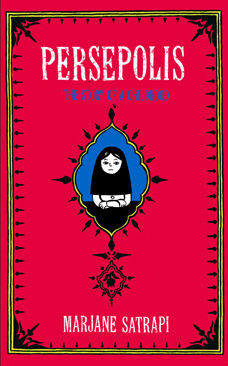In the early 2000s, Marjane Satrapi’s Persepolis set a new standard for graphic memoirs. Taking an inside look at the brutality and absurdity that overtook her native Iran in the early 1980s, Satrapi’s book met with resounding success amount casual readers as well as educators and librarians who embraced its capacity for increasing cultural understanding. Nevertheless, Satrapi’s memoir has been challenged numerous times over the years by those who do not appreciate its unflinching account of reality.
 Anyone who’s read Marjane Satrapi’s graphic novel memoir Persepolis is already familiar with the key events of her early life. Growing up in Tehran during the turmoil surrounding the Islamic Revolution, Satrapi experienced abrupt changes that curtailed the secular lifestyle she and her intellectual parents had enjoyed prior to 1979. Always rebellious and bluntly inquisitive, she began to act out even more in school and in public after her favorite uncle was killed in prison. For her own safety, Satrapi’s parents sent her alone to attend high school in Austria when she was 14, in 1984. She returned to Iran at 18 and obtained a Master’s degree in visual communication from Tehran’s School of Fine Arts, but found the prospect of remaining in the country under the repressive regime untenable. In 1994 she moved to Strasbourg, France, where she continued to study art, and on to Paris three years later.
Anyone who’s read Marjane Satrapi’s graphic novel memoir Persepolis is already familiar with the key events of her early life. Growing up in Tehran during the turmoil surrounding the Islamic Revolution, Satrapi experienced abrupt changes that curtailed the secular lifestyle she and her intellectual parents had enjoyed prior to 1979. Always rebellious and bluntly inquisitive, she began to act out even more in school and in public after her favorite uncle was killed in prison. For her own safety, Satrapi’s parents sent her alone to attend high school in Austria when she was 14, in 1984. She returned to Iran at 18 and obtained a Master’s degree in visual communication from Tehran’s School of Fine Arts, but found the prospect of remaining in the country under the repressive regime untenable. In 1994 she moved to Strasbourg, France, where she continued to study art, and on to Paris three years later.
Satrapi often regaled her friends in France with stories of her surreal childhood, and they, in turn, introduced her to comics including Art Spiegelman’s Maus. She had been dabbling in children’s picture books without success, butSpiegelman’ss work proved that illustrated books could treat more serious subjects. Satrapi decided to try her hand at a graphic novel memoir, and produced Persepolis in four volumes between 2000 and 2003. They met with immediate critical and popular acclaim in France, and were translated and collected into two volumes for the U.S. market in 2003 and 2004. In 2007 she co-wrote and directed the animated movie based on the comics, which tied for the Jury Prize at the Cannes Film Festival, won two French Césars, and was nominated for an Oscar and a Golden Globe.
While it’s hardly surprising that both the books and movie have been banned in Iran, Persepolis has also seen more than its fair share of trouble in U.S. schools, where parents and administrators have objected to profanities and depictions of torture. Most spectacularly, Chicago Public Schools officials made a confused attempt in March 2013 to remove the book from all classrooms due to “graphic language and content that is inappropriate for children.” They allowed it to remain in AP classes for 11th and 12th graders, but now require 8th-10th grade teachers to undergo extra training before they can use it in class. The book remains banned in 7th grade CPS classrooms. In 2014 there were two more school challenges to Persepolis in quick succession: one in the Three Rivers School District in Oregon, and another in Illinois in the Ball-Chatham district, where a review committee unanimously decided that it would not be removed from classrooms.
In Her Own Words
On banning books:
“The good thing is that these people who ban things, it’s like they are completely unaware of what a human being is. If you want to make adolescents read a book, ban it! And then they all want to read it. Because then they’re rebellious. Why not just explain it? It’s not like kids are dumb.”
– (Source: American Libraries Magazine)
After Persepolis was banned by Chicago Public Schools:
“It’s shameful. I cannot believe something like this can happen in the United States of America… These are not photos of torture. It’s a drawing and it’s one frame. I don’t think American kids of seventh grade have not seen any signs of violence. Seventh graders have brains, and they see all kinds of things on cinema and the Internet. It’s a black and white drawing, and I’m not showing something extremely horrible.”
–(Source: Chicago Tribune)
After the deadly attack on the Charlie Hedbo office in France:
“People have the right to have a different point of view and to provoke. If we allow acts like this to create a climate of fear, we will have lost our freedom.” (Source: New York Times)
Free CBLDF Resources
She Changed Comics
CBLDF Presents: She Changed Comics is the definitive history of the women who changed free expression in comics, with profiles of more than 60 groundbreaking female professionals and interviews with the women who are changing today’s medium, including Marjane Satrapi, Noelle Stevenson, G. Willow Wilson, and more! She Changed Comics also examines the plights of women imprisoned and threatened for making comics and explores the work of women whose work is being banned here in the United States. A must for readers of all ages, students, and educators.
| Graphic Novel | Author | Page in She Changed Comics | Resource |
|---|---|---|---|
 |
Marjane Satrapi | Page 77 | Discussion Guide |
 |
Marjane Satrapi | Page 77 | Adding Persepolis to Library or Classroom |
 |
Marjane Satrapi | Page 77 | Classroom Guide |



